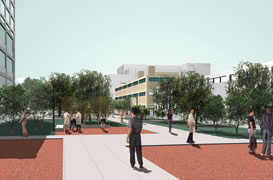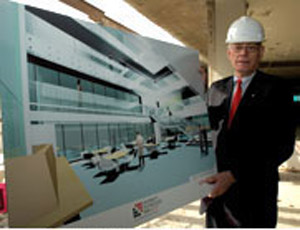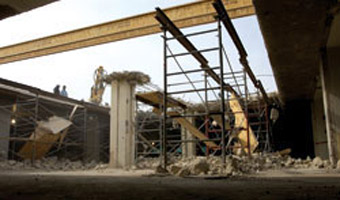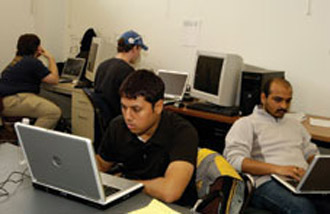
The corner of 35th and State streets at the southeast tip of IIT’s Main Campus is the locus for observing the future of Chicago’s Mid-South Side. With a 360-degree view of new construction and further development approved, activity at this intersection is signaling a neighborhood on the brink of a new era.
Central to this growth is University Technology Park At IIT(UTP), comprised of six pre-existing IIT buildings and three proposed new facilities. IIT’s newest contribution to the transformation of the South Side, UTP will provide science and technology companies with economically priced laboratory space, including incubator facilities, which are critical to the growth of many start-up ventures. When the project is complete, UTP will boast 1.5 million square feet of rentable space. Although the research park will provide university-wide opportunities, UTP’s benefits will extend well beyond IIT.
“When completed in 10 years, this will be huge,” says David Baker, vice president of external affairs at IIT and interim executive director of UTP, who, along with Dan Marselle (CHE ’78), associate director of technology and business services at UTP, is overseeing the project. “This is an unparalleled opportunity to make an indelible mark on the growth of this part of the city.”
Laying the Groundwork

The largest investment in the area since the 1991 opening of nearby U.S. Cellular Field, UTP is, by design, being built to foster an active mixing of science, commerce, and community. Its promise includes access to jobs and internships at UTP for IIT students and close proximity to company consulting opportunities for IIT faculty. UTP clients will be able to take advantage of a number of IIT resources, including use of laboratory equipment, conference facilities, and library and reference facilities, as well as an affiliation with a research university. The surrounding neighborhood will experience an influx of investment in the form of 2,500 job opportunities that UTP is estimated to generate over the next 10 years. UTP will join Chicago Technology Park, heretofore the only site for the development of biotechnology companies in the region, in promoting the growth and expansion of the life sciences industry in Chicago.
In an ongoing effort to enhance the Mid-South, the City of Chicago moved the Chicago Police Department headquarters to the corner of 35th Street and Michigan Avenue in 2000. At the same time, the city and the Chicago Housing Authority reached the critical decision to dismantle the failed public housing structures just south of Main Campus. Baker says those changes helped to lay the groundwork for UTP.
“If you had asked anybody in 1999 whether we could attract technology start-ups to 35th and State, they would have laughed at you, because in 1999, other than the new police headquarters being under construction, there was no indication of how quickly this neighborhood was going to change. Also in 1999, all the buildings that are part of UTP were owned by IIT Research Institute [IITRI], and the university had no interest in acquiring them,” says Baker. The 2002 spin-off of most of IITRI into Alion Science and Technology led to the university gaining control of the future UTP buildings. Now, market demand is working in tandem with reinvestment in the area to drive the development of UTP.
“The incubator at Chicago Technology Park has been filled for years, and companies were being turned away. As companies have outgrown those facilities, it has been very hard for them to create their next space. A lot of them have left the state,” says Baker, adding that UTP also will provide a potential new home for University of Chicago’s companies and research endeavors, further enhancing the relationship between IIT and U of C.
“Universities tend to have a bad reputation for dealing with commerce and business. But by creating UTP, IIT is saying that it means business.” —Said Al-Hallaj
To meet this need, UTP is being developed in three phases. Phase I includes the creation of a 30,000-square-feet Incubator in the former Engineering Research Building—originally designed by Mies van der Rohe—co-located with the research laboratories of IIT’s biomedical and chemical engineering faculties. The first 6,000 square feet of Incubator space, funded by the State of Illinois, includes room for four companies. The facility features wet and dry labs with adjoining, customizable office spaces and is equipped for clients to add portable natural gas, compressed air, and vacuum systems.
“It doesn’t stop with the physical needs,” says Vice Provost and Director of the Institute of Business and Interprofessional Studies Dennis Roberson, who has been involved with incubator facilities in South Carolina, Illinois, Malaysia, and Singapore. “Companies that don’t go to an incubator will experience a significant investment of time and money to get their business started. There are a whole set of needs that any new business has: business (including accounting, business plan development, financial planning, human resources, taxes, and payroll), legal (including patent filing and other intellectual property support, company formation, contract support, environmental issues, and mergers and acquisition counsel), and technical consulting and support. Incubator resources can provide all sorts of advice to help fledgling companies jump-start their businesses.”

Phase I also includes Technology Business Center 1, previously called the Chemical Research Building, a $50 million, state-of-the-art, build-to-suit facility for companies needing 3,000-15,000 square feet of space. IIT engaged Wexford Science and Technology, LLC, a private developer with strong expertise in research park development, as its partner on the project. Wexford acquired the building from the university and used private-sector financing strategies, city and federal incentives, as well as private equity and debt financing to fund the construction. Work on this facility began in January. The building will be ready for tenant occupancy in summer 2006. Also part of this phase, IITRI Center, now home of IIT Research Institute Life Sciences Group, just completed a $20 million expansion.
In addition, software and information technology companies are now locating in IIT Tower, where affordable space goes hand-in-hand with the availability of skilled IIT computer science students.
Subsequent phases will include renovation of other existing buildings in UTP and expansion to the parking lots on the east side of State Street, once a new parking garage is built.
Enriching the Client Experience
Two clients taking early advantage of UTP are Said Al-Hallaj and J. Robert Selman, professors in IIT’s chemical and environmental engineering department. In 2001, Al-Hallaj and Selman formed All Cell Technologies, LLC to develop and commercialize lithium-ion batteries for portable power and electric vehicle applications. Last year, Al-Hallaj and some of his students launched Sun Phocus Technologies, LLC, a company that is working to develop and commercialize solar powered windows for use in generating electricity for office buildings. All Cell and Sun Phocus moved into a new laboratory space in the Incubator in February and began operating there in March.
Al-Hallaj says that his companies’ affiliation with UTP is already starting to pay off. “With All Cell, we approached the City of Chicago about working on a Plug-In version of the hybrid Ford Escape. Our affiliation with IIT gave us a lot of credibility. If I had gone to the city on my own, I don’t think I would have received the same response.”
While UTP is largely being marketed to and suited for biomedical engineering and life-sciences companies, another client, a digital data storage start-up called Cleversafe, is growing steadily thanks in part to a talented workforce: IIT students.

Chris Gladwin, Cleversafe’s founder and CEO, says he moved his company into 3424 South State and began hiring IIT students last winter. It started with one part-time student, then two, and now 15 current or recently graduated IIT computer science and design majors are among his 22 employees.
Gladwin says that compared to employees with backgrounds in one area of expertise, students have proven to be more creative and adaptable. “This is my third major start-up; at the previous two, I hired people who had 20 or 30 years of experience,” says Gladwin. “IIT students are better for the work we do: it’s technology-driven, but creative. It’s better suited for smarter, creative people, and these students have what we’re looking for.”
Cleversafe is benefiting from IIT students in other ways. In March, as part of a contest run by the College of Architecture, two architecture students were selected to design Cleversafe’s new office in the Tower, to where the company will expand this summer. Another student won the rights to be project manager.
“That sort of thing would not happen if we weren’t at IIT,” Gladwin says. “I’ll have access to brilliant architects, and I have a great story to tell my clients about why my company is interesting. And because we’re on a campus at a major research university, we have a lot more credibility.”
Creating a Win-win-win Situation
At the outset of IIT’s 1996 Master Plan, created by Trustee Dirk Lohan as part of the National Commission for IIT, the south end of campus was designated for future commercial development. In 2000, President Lew Collens saw an opportunity for an on-campus technology park to give faculty the chance to be more entrepreneurial and to form more companies of their own.
With IIT able to leverage existing buildings on campus, the campaign for UTP began. In October 2005, the City of Chicago, at IIT’s request, created a Tax Increment Financing (TIF) district on the south end of campus. This designation enabled Wexford to receive $13.4 million in tax increment financing, allowing it to renovate the building and still charge affordable rents to technology companies.
The UTP construction timeline now coincides with the creation of IIT’s 2010 Plan-the set of university priorities that will capitalize on IIT’s strengths in research and academics into the next decade. The university has identified life sciences, energy and sustainability, entrepreneurship, and its continued Interprofessional Projects (IPRO) program as key priorities. Roberson says that UTP will marry well with the initiatives included in the 2010 Plan. As UTP evolves, company employees could propose new IPRO projects and offer the participants appropriate feedback, and students could provide companies with reasonably priced market research, accounting services, and other business assistance ‘thereby enriching the students’ own entrepreneurial experience.
“Since UTP expects to house companies from a variety of areas, it will have a very positive impact across IIT. The opportunity for students to engage with firms right on campus is wonderful, and faculty members have the opportunity to be on advisory boards for companies and to act as part-time consultants,” says Roberson, who will serve on the board of Cleversafe. “The companies can get experienced people to help support them, while faculty have the opportunity to delve into the ‘real-world challenges’ associated with the areas they’re interested in, all in the context of an entrepreneurial business environment. It’s a terrific win-win-win situation.”
Market demand is working in tandem with reinvestment in the area to drive the development of UTP.
If UTP is as successful as other university-affiliated research parks, its benefits could extend well beyond the immediate community. Research parks have had a transformative effect on their local economies: Stanford University’s research park, and more recently, Research Triangle Park’s collaboration between Duke University, North Carolina State University, and University of North Carolina Chapel Hill are two such examples.
“Ours is a more modest goal focused on trying to create economic growth to complement the residential and commercial activity here now,” says Baker. He cautions that while attracting occupants to a park of this size always presents a risk, ultimately, IIT’s ownership of UTP is a distinguishing factor when compared to other technology parks within the Chicago area, including Illinois Science + Technology Park in Skokie, which opened in 2005.
“Our selling point,” says Baker, “is that we are looking for companies that want to be on a university campus, to employ our students, and to use the academic and research resources that we have here. That’s a main difference between what’s happening here compared to the more industrial focus of the Skokie facility.”
A Broad Effort
As activity at UTP, and UTP itself, continues to advance, so, too, will the area surrounding the park. A variety of amenities planned for the neighborhood are expected to help attract UTP’s clients and prospective residents to the neighborhood. This includes a new federally funded Metra stop at 35th and Federal streets, which Baker anticipates will be completed within five years, and commercial and residential development.
A new residential development directly south of the Tower, Park Boulevard, officially broke ground in December 2005. The privately held, 1,300-unit, mixed-use community-which will rise in place of a former public housing site-will include spaces for restaurants and other businesses. At the groundbreaking ceremony, Chicago Mayor Richard M. Daley had strong praise for the complex, referring to Park Boulevard as a place that will ‘rebuild the souls’ of the people who will live there.
With the development of UTP and its surrounding neighborhood underway, a series of projects more than a decade in the making are just beginning to transform what was once a bustling metropolis for music and commerce in Chicago. As the city, state, and IIT work together to realize this goal, the university’s commitment through UTP is shaping up to be a bold investment in the neighborhood that once thrived around IIT.
Says Roberson, “It’s synergistic: as UTP becomes more successful, it will contribute to the surrounding environment, which will in turn contribute to UTP’s success. It’s a virtuous cycle.”